Nosy Crow's Blog, page 188
March 3, 2014
Nosy Crow Apps at GEEK2014
Picture by David Good Videography.
Children and their families had the chance to read and play Nosy Crow’s apps at GEEK2014 – a festival of games and play held annually in Margate. Emily Guille-Marrett, early reading expert, mum of two and organiser of GEEK’s Story Time event for 3-7 year-olds, has written a guest blog for us on why she chose to feature our apps, and looks at highlights from the event.
Why Nosy Crow Apps?
Fairytales and traditional tales have been collected and shared by storytellers around the globe for hundreds of years. Storytelling is rooted in our history and heritage. It is also rooted in gaming. As a publishing house producing both printed picture books and innovative story apps, Nosy Crow manages effectively to straddle reading and gaming with storytelling at its heart.
Story Time: Tell, Read and Play
I was keen to create a story event at GEEK which would explore traditional tales and fairytales in multiple forms. Children were invited to tell stories, listen to and read picture books and play fairytale apps by Nosy Crow. Margate’s Turner Contemporary generously loaned GEEK iPads so boys, girls and their families could read and play the apps for themselves.
1. Telling traditional stories
Encouraging children to tell traditional stories can have a positive impact on their reading and writing. They become familiar with features of the genre, such as learning how to start and end a traditional tale. And as their collection of stories-to-tell expands, they are able to draw from this resource, innovate on and create their own stories. This was something I was lucky enough to learn from educationalist and storyteller Pie Corbett. when I published his work a few years ago.
Inspired by his techniques, I showed children how to use actions and repetitive phrases to retell the Enormous Turnip and other favourite tales. It was fun to see so many children shouting, laughing and acting out phrases such as “He pulled and he pulled with all his might, but still the enormous turnip would not come up.”
2. Reading playful picture books
There is a wealth of beautifully illustrated traditional tales and fairytales to read with your child. However, I decided to engage the children at GEEK with contemporary picture books that play with and are inspired by traditional stories. Partly, I just wanted to entertain the children – fractured fairytales are great fun! But I also wanted to demonstrate that playing with traditional stories, hacking, borrowing from and mixing them up, is not that dissimilar to features of contemporary gaming.
As the age range of children in the audience was quite broad (3-7 years), I was careful to ensure that we had an appropriate story for everyone. Our range included:
• The Very Little Red Riding Hood by Teresa Heapy and Sue Heap
• Goldilocks and Just One Bear by Leigh Hodgkinson.
• Mixed Up Fairytales by Hilary Robinson and Nick Sharratt
• The Three Little Wolves and The Big Bad Pig by Eugene Trivizas and Helen Oxenbury
• The Stinky Cheeseman and Other Fairly Stupid Tales by Jon Scieszka and Lane Smith
• Revolting Rhymes by Roald Dahl and Quentin Blake
Once children had finished reading the picture books it was time to play Nosy Crow apps!
3. Reading and playing Nosy Crow apps
I cut short my demo of the Nosy Crow apps because, in all honesty, the children couldn’t wait to have a go at reading and playing the fairytales on the iPads themselves. The youngest child was a 3-year-old girl and she played Nosy Crow’s The Three Little Pigs. The oldest child was a boy about 7-years-old and he played Jack and the Beanstalk. Other children played these and also Cinderella and Little Red Riding Hood.
One mum admitted that she was quite concerned about her 5-year-old playing on tablets but would definitely be happy for him to use story apps by Nosy Crow. Another gentleman explained that he had lots of grandchildren and an iPad. He had been unsure which apps to download and couldn’t believe the level of interactivity and quality for £2.99.
Storytelling past, present and future
GEEK is a great opportunity for people to challenge the status quo, showcase products and play with ideas. I was keen to see how I could engage 3 to 7 year-olds with storytelling in a variety of forms from traditional oral re-telling to printed picture books, and in digital form using Nosy Crow apps.
As someone who has worked in educational publishing, creating products to help children learn to read for over 13 years, I will always wax-lyrical about the importance of talking to children, telling stories and sharing printed books with them. I have also published reading and writing software for teachers to use on interactive whiteboards in schools and seen that new technology has the power to engage, inspire and teach children.
What I’m learning is that, with the right products, new technology has the power both to engage children to want to read and enjoy reading. It is true more research is needed to investigate the negative and positive impact of digital technology on children’s reading habits. But it’s interesting to think about the printed story book as a way into accessing digital skills and new technology as well as considering the digital story App as a way into reading.
What excited me most about the Story Time session at GEEK was that these young children were as engaged reading the picture books as they were playing on the iPads. A great outcome for bookworms and gamers!
I am grateful to Kate Kneale and the organisers of GEEK2014 for hosting Story Time and to Margate’s Turner Contemporary for loaning their iPads for free so children could enjoy reading and playing the Nosy Crow Apps. With thanks to Charlotte Raby, literacy expert and educational writer, for her help.
Thank you, Emily, for sharing these highlights! You can find out more about Emily Guille-Marrett’s work at Reading Fairy.

March 2, 2014
We're all doomed - or are we? Reflections on Robert McCrum's article for The Observer on the end of writing as a way of making money
We – OK, I – felt a bit weary, but pretty chipper this weekend, after a few days at what seemed to me to be a particularly informative Independent Publishers Guild Conference at the end of last week. We even won a few prizes.
Then I read this piece by Robert McCrum about “the end of an author’s life”, and I felt a bit glum and a bit cross. He’s not talking about a particular author who has died; he’s saying that writing as a way of making a living has died. He’s writing about literary authors, and that’s not really my area of expertise, but it’s all a bit James-Laurie-as-Private-Frazer: “We’re all doomed”. And it seemed to me to be another worrying example of media coverage of writing, reading, publishing and bookselling teetering on an edge – a “heritage” thing, that needs protection to survive.
I used to work with Robert McCrum. Well, I use the word “with” loosely, as I’d be amazed and flattered if he were be able to pick me out in a line-up. But he was Editor-in-Chief at Faber while I was a rights assistant, and, later, after someone left and my boss was incapacitated for many months with intractable amoebic dysentery (that he claimed he’d contracted from a Cornish pasty he’d bought in Taunton, but I was inclined to attribute to a recent trip to Pakistan), I got the title of rights manager. Senior members of staff (a group including Robert McCrum that was referred to by junior members of staff as “Evans Above” after Faber MD Matthew Evans, now Baron Evans of Temple Guiting) spent a lot of time at lunch, and even more at The Groucho Club, and Faber, in particular, grew fat on income from Cats, The Musical. What I am trying to say here is that the experience of publishing that Robert McCrum looks back on so fondly was not really terribly representative of the industry even as it was then (as I discovered when I moved on from Faber). And incidentally, I am pretty sure that many of the writers that Robert McCrum was publishing at Faber back then struggled to make a living from writing.
I think that there are several things to say here.
The first thing I’d like to say is that it would be stupid to deny that publishing has been hugely disrupted over the last few years. Like most industries, it’s been disrupted by financial crisis. Like many industries, it’s been disrupted by technology. Not only is the way that many of us read and write shifting from paper to screen (I’m not talking just about books, here, but about any and all kinds of reading and writing), but the way that we buy what we read has now at least partly moved online too (Amazon represented 37% of the UK’s total print and ebook market last year, and in the US it’s closer to 50%). Technology brings with it concerns about piracy – probably exaggerated where books are concerned – and the spectre of the death of copyright. The principle that makers should own what they make and should be compensated for its use one that I profoundly believe in, but it’s a bigger idea than the scope of this particular blog post. UK print book purchasing shows a long-term pattern of decline (it’s worth saying right now that purchasing of children’s print books remains cheeringly resilient). The loss of independent book shops (now down to under 1,000 in the UK) and book shop chains like Borders has reduced the number of physical spaces in which people can discover books. There are surveys, including PISA and Nielsen’s Books and Consumers surveys, that are worrying for those of us who care about literacy, as they suggest that reading standards are falling, and, for those of us who care about literacy and books, suggesting that children report less engagement with reading.
But the idea that technology and change are the enemies of reading is just plain wrong. We read more now than we’ve ever done. Even if you ignore the explosion in reading of non-books, including blogs and other online-only writing, combined sales of print and ebooks rose in the US by 14% between 2008 and 2012. More of us are creating content than ever before, and many of us are finding, through technology, new ways of reaching our audiences. Technology and change have provided us with new ways of connecting with one another to recommend and talk about books. And technology and change have provided us with ways of making entirely new kinds of reading experiences including our own highly-interactive multimedia apps, and reading experiences like Fish or Blackbar or Faber’s (do you see what I just did, there?) The Wasteland App (Faber is a brilliant publisher).
The second thing I’d like to say is that any implication that publishers are battening on writers and underpaying them feels to me to be wrong. The article focusses on advances, not royalties, and the truth is that I cannot imagine that there’s a trade publisher (as opposed to an educational, academic or professional publisher, whose business models I’m not so familiar with) out there that does not have to write off unearned advances at the end of the year: this is the money you pay in advance to authors that you know they won’t ever earn out. For some adult trade publishers that I can think of, or for a publisher who takes a massive gamble on something that doesn’t pay off, it can be as much as the amount the authors actually earn in royalties. So if, as is the case with Nosy Crow, maybe around 15% of a publisher’s sales revenue is paid to authors as royalties, for certain publishing companies – probably the ones that Robert McCrum’s anecdotes relate to – there’s an additional 10% to 15% of unearned advances to account for. This means that many publishers are paying between a quarter and a third of their total sales revenue to authors. I’ve written about how publishers like us pay authors here. And if you’re wondering what publishers do with the rest of their revenue, you might want to read this. Of course, unlike the days that Robert McCrum looks back on with such nostalgia, authors now don’t have to rely on publishers to find their audience at all. They can self-publish in a myriad of ways, and a few of them do so very lucratively. If, as publishers, we can’t articulate why it will be better for a given author or illustrator to publish with our own publishing house rather than to self-publish, we shouldn’t be publishing that author or illustrator, and if we can’t be convincing on this point regularly, maybe shouldn’t be in business.
The third thing I’d like to say is that no-one owes authors (or illustrators) a living. No-one owes publishers or booksellers a living either, for that matter. Of course I think that there is a role for state support of reading. I think that there is cultural, social and long-term economic value in keeping public libraries open. (If you’d like someone to articulate that view better than I ever could, here’s Caitlin Moran on the subject). And I for one support tax spend on school libraries and on early intervention programmes for children who otherwise wouldn’t be exposed early on to reading, to name just two other literacy-building opportunities. But, otherwise, writers, publishers and booksellers do – and I think should – stand or fall by whether they are producing things that people want to read and buy. The truth is that it’s always been the case that there are writers who make a great living out of their writing and writers who don’t. We remember Dickens and Enid Blyton and J K Rowling and EL James, and we forget most of those who made less of a commercial impact. I am not saying that there’s necessarily a link between being commercially successful and culturally interesting or impactful. I entirely accept that there’s great stuff being written out there that hasn’t, or hasn’t yet, reached its audience (I am thinking of a book like Stoner, widely read and commercially successful only 50 years after it was first published). But the market-place is the mechanism we have, and I can’t think of a better one that wouldn’t be at least as unfair or subjective.
There’s no point being Pollyanna-ish, and pretending that these aren’t times of challenge as well as opportunity in the book business. However, it seems to me that articles about the commercial demise of writing and reading (particularly if they’re illustrated with a big photo of a writer tapping away on a shiny Mac in a perfectly lovely kitchen, but that’s another point), may actually put off the audience that we need to gain, excite, engage and retain. The Robert McCrum piece risks sounding a little bit… whiny, and coverage like this makes it sound as if all of us engaged in the book industry are collectively some sad, fat, old dodo stumbling helplessly about on the forest floor waiting for extinction. Let’s, instead, focus on telling people what great stuff, new and old, we have for them to read, and make it easy for them to find it, buy it, and tell other people about it.
I really enjoyed this rebuttal of the Robert McCrum piece too.
What do you think? Is it getting harder or easier for authors to publish and to live than it was 25 years ago, or even five years ago? Is the entire book industry going to hell in a handbasket or evolving to meet the challenges and opportunities of technology? You can comment here or on Twitter and we’d be really interested to hear from you.

February 27, 2014
Nosy Crow wins two awards - again! - at the Independent Publishers Guild Awards
Tom, Ola and me with our awards at the IPG award dinner last night
Last night was just the third time Nosy Crow has attended the Independent Publishers Guild Awards. And, amazingly, for the third time we came away with prizes. Having been shortlisted for four awards this year, and with both Ola and Tom shortlisted for the IPG Young Independent Publisher of the Year Award, we won the 2014 Digital Marketing Award, sponsored by Nielsen, and the 2014 International Achievement Award, sponsored by the London Book Fair.
We were very surprised. It really did seemed far, far too much to hope for to think that lightning would strike three times. We won three awards in 2012 and two awards last year, after all, so to think we might get any more just felt plain greedy. But I was incredibly pleased that Nosy Crow won these particular prizes: Tom and Ola were with me at the awards ceremony, and Tom put in most of the work that won us the 2014 Digital Marketing Award, while Ola put in most of the work that won us the 2014 International Achievement Award.
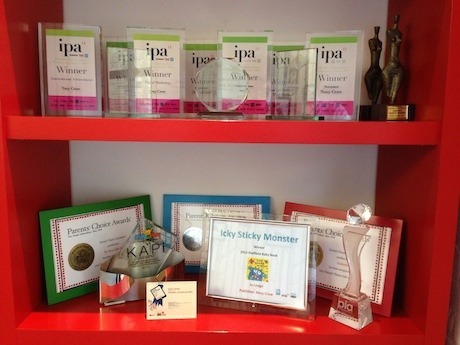
Nosy Crow’s awards shelves
We were one of two multiple award winners on the night. The other, I am really delighted to say, was another children’s publisher: it was Usborne, a company that, with pretty much everyone else in children’s books, I think, I hugely admire. Usborne celebrated its 40th year of independent publishing last year. In an email from Bridget Shine to all Independent Publisher’s Guild Members, she says that Usborne pipped Nosy Crow to the post to win Children’s Publisher of the Year (nice to know that we were serious contenders for that prize again!), but they also won the overall Independent Publisher of the Year Prize, which the children’s, trade, educational, specialist and academic and professional prizewinners all go on to contend. Peter Usborne, who is what is described as “an industry veteran”, got a standing ovation when he picked up the overall Independent Publisher of the Year Award, and many of us in the room felt a little bit lumpy-throaty as he went up to the podium to pick up his prize. I think that it’s such a great thing for children’s publishing in general that a children’s publisher has won the overall award – the second time it’s happened in the eight-year history of the prizes. And, frankly, if you are going to lose to someone, who wouldn’t 100% prefer it to be Usborne after their 40th year than anyone else?
The compere for the evening, Rosie Goldsmith, did a good job of keeping things upbeat and on track, but I did feel a tiny bit that, in her opening remarks, her friendly jokes about the nature of independent publishers – poor, uncommercial, often bearded – didn’t reflect the community of IPG members that I’ve come to know. They certainly don’t reflect how I want to be seen, so it was kind of nice to have the opportunity – in a nice way: you had to be there! – to take issue with what she said when I went up to collect our first prize. I said that I didn’t want to be poor, and that Nosy Crow was commercial (and, I could have added, I was bristle-free at least yesterday evening, too). Yes, as she’d said, independent publishers like Nosy Crow publish with passion and conviction, and yes, we are free, and proud, to publish into the niche markets, some tiny, that reflect that passion and conviction. But publishing with your heart doesn’t mean that you don’t also publish with your head. I want Nosy Crow to be as professional and business-like as any corporate publisher – for ourselves, for our customers, for our readers and their parents/teachers/librarians, for our authors and illustrators. To be independent is not to be, somehow, amateur or nostalgic or a bit bonkers. It’s been said before by people cleverer than me, but the internet flattens the playing field between small and large players, in publishing and in other industries, and an advantage that independent publishers have is that they don’t have to ventriloquise a corporate voice. Instead, they can turn their scale and their personality into an advantage. I’d like to think that it was, in part, Nosy Crow’s distinctive voice – not something we “put on”, but, instead, just a reflection of our personalities – in things like this blog and on social media that won us the Digital Marketing Award, and we love the opportunities that the internet gives us to have proper conversations with readers, parents, grandparents, teachers, librarians, bookshops, authors and illustrators that we otherwise might not have.
What won us the International Achievement Award, as well as Ola’s sterling efforts, was the support of the publishers outside the UK with whom we work closely, including Candlewick Press, Allen and Unwin, Gallimard Jeunesse, Carlsen Germany and Gottmer. Christine Baker, Editorial Director of Gallimard Jeunesse, was kind enough to provide a testimonial as part of our entry for this award. This is what she said:
“The tightly-knit and enthusiastic Nosy Crow team performs with ever-increasing energy, professionalism, dedication and creativity. They never rest on their laurels and keep thinking out of the box. Their speed of reaction and responsiveness is equal to their sound expertise of books and children, and we enjoy with Nosy Crow a model of fruitful and efficient collaboration in a relationship which is always enjoyable, trusting and constructive. The quality of the books and customer satisfaction are paramount for Nosy Crow, who are partners in every sense, far beyond editorial exchanges and punctual delivery of the books they produce for us. We also emulate and are inspired by their dynamic marketing and communication innovations, always helpfully shared. Nosy Crow has provided us with several of our best-selling picture and novelty books for young children of 2013. This success extends to fiction: the Nosy Crow debut, The Secret Hen House Theatre, is shortlisted for the prestigious Prix Sorcières.”
Both Peter and I spoke in our short acceptance speeches about the remarkable ability that UK children’s publishers have to select and make books that sell well right round the world. For a children’s publisher to win this prize for the second year running helps to bring a bit of attention to the professional skills and global sensibilities of our sector of the book business.
Here’s the full list of prizes and winners:
Nielsen Digital Marketing Award
Nosy Crow
The London Book Fair International Achievement Award
Nosy Crow
IPG Children’s Publisher of the Year
Usborne Publishing
IPG Independent Publisher of the Year
Usborne Publishing
IPG Trade Publisher of the Year
Summersdale
Frankfurt Book Fair Academic & Professional Publisher of the Year
Edward Elgar Publishing
Librios Education Publisher of the Year
Crown House Publishing
PrintOnDemand Worldwide Specialist Consumer Publisher of the Year
Absolute Press
Ingram Content Group Digital Publishing Award
Faber & Faber
The Nick Robinson Newcomer Award
Critical Publishing
IPG Diversity Award
Accent Press
IPG Young Independent Publisher of the Year
David Henderson, Top That! Publishing
GBS Services to Independent Publishers Award
Compass Independent Publishing Services
So, just slightly the worse for wear after a long-ish evening of celebration, we’ll pack up our prizes and get back to work later today: the Bologna Book Fair is just around the corner, and we’ve lots to do.

May Contain Nuts...
Finished copies of Nuts in Space, the hilarious new picture book by Weasels author-illustrator Elys Dolan have just arrived in the Crow’s Nest, and they look magnificent!
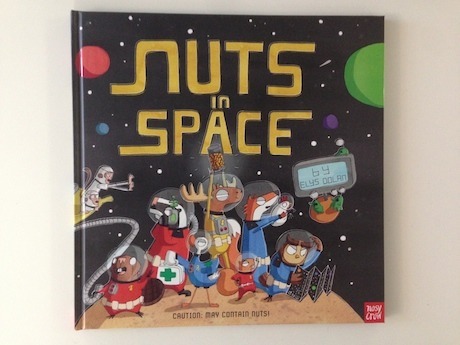
A laugh-out-loud picture book (with a simply stellar story), Nuts in Space is absolutely PACKED with puns, visual gags, and all sorts of detail – this is a book to pore over again and again.
An elite crew of furry animals have found the Lost Nuts of Legend, a mythical snack rumoured to give the bearer unimaginable blessings such as teeth that never need brushing, rooms that never need cleaning and underwear that never needs changing. Now all they have to do is go home, but everyone is starving, the Star Nav is broken, and it was a REALLY bad idea to stop at the Death Banana. Will the crew ever find their way home? And, most importantly, will they get there before someone EATS the Lost Nuts of Legend?
You can take a look inside the book here:
It’s not published until April, but you can pre-order Nuts in Space online here. Elys’ debut book, the Roald Dahl Funny Prize-shortlisted, Greenaway Medal-nominated, and Waterstones Children’s Book Prize-shortlisted Weasels, is out in paperback now – you can order it online here.

February 26, 2014
Why do boys love dinosaurs?
Today’s guest post is by Kim Werker, a Vancouver-based writer and editor.
I remember learning about dinosaurs and fossils when I was in kindergarten. I had such a romantic fascination with them. How disappointing to learn only a few years ago that the beloved brontosaurus really should go by another name.
Maybe it’s our never having encountered an actual dinosaur that makes them so fascinating. Or maybe it’s their storied size. Or maybe it’s literature, which so vividly imagines and personifies them for us from the time our eyes can focus on the page.
My nostalgia for my childhood love of dinosaurs took on new depth when I walked into my local library with my two-and-a-half-year-old son Owen a few months ago, and listened as he belched out his first capital-I important question to the poor woman behind the desk who seemed as stuck for an age-appropriate answer as I was. “Why dinosaurs are essinct?” he asked. She blanched.
Though I took his question seriously and embarked on a fairly fruitless search for books that tackle such a question satisfactorily for a reader who has understanding neither of time nor death, I quickly learned that fictional dinosaurs satisfy his curiosity just as well. I’ll leave him to decide when he’s a little older whether to have nightmares about balls of fire crashing into Earth.
My childhood interest in dinosaurs was different than Owen’s. At just three, he can name a dozen species on sight (I never went beyond the most common handful). He is a cataloguer of his interests in a way my friends lead me to believe is typical of their sons, too. Before they’re potty trained, these boys school us on the differences between backhoe loaders, skid steer loaders and excavators. It leads me to wonder why. Why is there such a stereotype about boys and vehicles and dinosaurs and sport balls? Why does my son embody the stereotype so fully when I tried so hard from the beginning to expose him to things like unicorns and rainbows? Why does he correct my mislabels of bulldozers while he shows no interest in princes or princesses?
It seems a young child’s interests are all or nothing. Owen loves dinosaurs, every sort of vehicle, Busytown, land animals and sea creatures. About other things he may show interest for a few minutes at a time, but when it comes to these very stereotypically boyish things he is known to spend an entire hour moving from zooming toy cars to flipping through a book about trains to flying a helicopter through the air to putting out pretend fires to squealing for me to protect him from a hungry T. Rex.
I try to talk to him about princes and princesses, and he changes the subject. I offered once to make him a tutu after he commented on a little girl wearing one in the grocery store. He put his hand on my arm, looked at me without a hint of humour, and said in a quiet voice, “No tutus.”
One evening, when my brother phoned for help buying Owen a book for his birthday, our conversation went something like this:
Me: “Go find a display of picture books and tell me about one that jumps out at you.”
Him: “Mmm. There’s one here with cupcakes on the cover. It looks cool. Exciting.”
Me: … “What else do you see?”
Him: Shuffles around, muttering under his breath. “Well, there’s one here with a dinosaur driving a fire truck, and–“
Me: “Stop right there. He’ll love it. Doesn’t matter what’s inside.”
Helping an uncle buy a good gift is different from a parental desire to expose one’s child to great stories, delightful art and skillful writing. I admit I had low expectations for the quality of this book my brother found, such is my experience of books banking on gendered stereotypes, but I also know that a book involving both dinosaurs and rescue vehicles would be a sure hit, which is what a gift from an uncle to his nephew should be.
Imagine our collective delight when we discovered that the book, Dinosaur Rescue, by Penny Dale, is actually gorgeously illustrated and skillfully written. There isn’t a hint of lazy pandering in it. And imagine our further delight when we discovered she’s writing a series of books that involve dinosaurs and vehicles. We’ve since added Dinosaur Zoom! into frequent rotation.
Going to the library with Owen, I’ve become humbled by the importance of book covers for children’s books. He cannot read, but he navigates the low shelves of picture books with the discerning eye of a kid who knows exactly what he wants. Pulling books half off the shelf as he goes, he only stops when he sees one of his stereotypical interests – a train, a race car, a dinosaur, a spaceship. Only once in his life has he pulled out a pink title (and even that one was more of a muted purple).
Determined to raise a son who doesn’t shun things that are “girly”, I’m frequently at a loss in the face of his dogged determination to ignore all the other stereotypes I try to nudge in his direction. At a loss, but no less fascinated by it. I look forward to seeing how his interests evolve as he grows up.
Evolution. There’s a topic we’ll no doubt have fun exploring together in books.
Thank you for sharing this, Kim! Kim’s next book, Make It Mighty Ugly, is due out in September. She occasionally writes a blog called A Short Read about her adventures reading with her three-year-old, and you can find more of her work at www.kimwerker.com. Dinosaur Rescue, the third book in Penny Dale’s dinosaur series, is out now – you can take a look inside below.
Order the book online.

February 25, 2014
Win copies of our March titles!
It’s time for our monthly book giveaway! You can win any of our upcoming March print titles – and here’s how. If you’re a resident of the UK or Ireland, you can win any of next month’s releases simply by subscribing to our Books Newsletter and sending us an email with the book you’d like to win. Here’s what’s up for grabs…
The board book edition of Guinea Pig Party by Holly Surplice is out next month – a charming picture book featuring the world’s cutest guinea pigs. Based on a familiar childhood counting rhyme and combining birthday fun, counting and cute fluffy animals, this is the perfect birthday gift for pre-school children everywhere. Here’s a look inside:
We’re publishing The Princess and the Presents by Caryl Hart and Sarah Warburton – the follow-up to last year’s phenomenally successful The Princess and the Peas. Princess Ruby really is a horrid child – the most spoilt princess you could ever meet. And when it’s her birthday, there are so many presents the palace literally bulges at the seams. Was there ever a more selfish princess? But when the palace and the gifts finally collapse under the poor king, the tiny tyrant realises that she has overlooked the most precious thing of all. And, luckily for Ruby, it’s never too late to make amends. Here’s a look inside:
You can win Littleland All Day Long by Marion Billet, the paperback edition of Littleland. Designed to stimulate speech and build vocabulary, this busy book is full of familiar scenes and fascinating detail. With a ‘Can you see?’ feature on every spread and a simple, chatty narrative, Littleland mimics the daily conversations between mother and child and makes the perfect next step up from board books. Here’s a look inside:
The Rescue Princesses: The Rainbow Opal by Paula Harrison is up for grabs – the eleventh volume in the fantastic Rescue Princesses series. When a young koala cub becomes ill in the kingdom of Mirrania, the Rescue Princesses must find a cure, even if it means going into the bush in the middle of the night. They just hope the magical Rainbow Opal can keep them safe… Here’s the first chapter:
And finally, we’re publishing an exciting debut: Cowgirl by G. R. Gemin – a funny, moving story for 9+ year olds, with strong female characters and big-hearted social realism (think Michael Morpurgo meets Jacqueline Wilson), by an outstanding new writer. Here are the first three chapters:
To win, all you have to do is subscribe to our books newsletter (if you’ve already subscribed you’re still eligible for this competition) and send an email to tom@nosycrow.com with “Newsletter competition” in the subject heading and the title of the book you’d like to win in the body of your email. So have a good think about which book you’d like to win (we can only accept one entry per person), and good luck – we’ll pick the winners at random next week.

February 24, 2014
There's one week left to apply for a Junior Editor position at Nosy Crow
There’s just one week left to apply for our Junior Editor vacancy at Nosy Crow!
We’re looking for a creative, dynamic Junior Editor to work on our award-winning list of full-colour books. Working closely with the Editorial Director, Head of Picture Books and the design team, you will be project-managing a number of your own titles, both picture books and novelty, as well as overseeing our paperback and board books programmes, plus some marketing material. Passionate about children’s books, with a good understanding of both the UK and international markets, you will be committed to making high quality, commercial titles that stand out from the crowd.
You can read more about the vacancy, and the full job description, here – the closing date for applications is this Friday, February 28, and if you’re interested, you should send our Editorial Director, Camilla Reid, your CV, accompanied by an application letter, as soon as possible via email (camilla@nosycrow.com).
Good luck!

February 21, 2014
Our first fairytale app is free until the end of the weekend!
This week we celebrated the third birthday of our first fairytale app, The Three Little Pigs, with a giveaway – for the first time ever, you can download the app for free.
And there’s only a couple more days left!
You’ve got until Sunday to get the app for free, before it returns to it’s normal price of $4.99 (£2.99) – what are you waiting for?
With original artwork, animation, music, children’s voices, and lots of dialogue and interactivity, The Three Little Pigs reimagines the classic fairytale for a new generation. The Huffington Post called the app “a masterpiece” and The New York Times described it as “one of the best renditions of the classic story in the app store.”
If you do download The Three Little Pigs, we’d really appreciate it if you’d consider leaving a review on the App Store. And if you like the app, why not try some of our other fairytale stories! You can download our latest app, Jack and the Beanstalk, on the App Store here – it’s our best one yet.

Life After CEO - reflecting on being fired and what happened next, after speaking on The Bottom Line with Evan Davis
Evan Davis in the recording studio
I’m writing this four years on from the day we announced the existence of Nosy Crow, so I hope you’ll indulge what is a very personal blog post.
I love the BBC Radio 4 programme, The Bottom Line. I think Evan Davis is a great interviewer – informal but serious, probing but not aggressive – and I really enjoy all the insights I get into different businesses and different ways of thinking.
For people who don’t know it, and who want a book- or app-related way into it, then Books with Victoria Barnsley (then at HarperCollins), Jonny Geller of Curtis Brown and Michael Tamblyn of Kobo, or The App Industry with Touch Press founder Max Whitby would be great places to start.
Anyway, as a fan of the programme, I was hugely flattered to be asked to participate, even if the subject, “Life After CEO” wasn’t necessarily one I’d have chosen, and the other guests, Lord Browne, who ran BP, and Robert Polet, who ran the Gucci Group, were seriously out of my league, having been at the very top of multi-billion pound corporations.
The programme was broadcast yesterday evening, and will be on again on Saturday 22 February.
Participating in the programme meant saying something openly that I hadn’t quite put on the record publicly before: I was fired. That’s why I stopped being a CEO. Just five months into a new role running a big adult imprint in a big publishing corporation, I lost my job. We announced the existence of Nosy Crow four-and-a-half months later. Being fired after over 20 years on the corporate ladder was as painful and humiliating and anxiety-inducing for me as it is for anyone else, even if I justified it by saying that, after just five months, it’s not about measurable performance, but about perception of fit.
Lots of people get fired (or made redundant) and lots of people fear losing their jobs, so I thought that it might be a tiny bit helpful to any of them listening if I said that, yes, it was devastating, but that it wasn’t the end of the world – that there was, indeed, “life after CEO”, or after any kind of job loss, come to that.
Recording the programme – no multiple takes, no rehearsals – required an hour and a half of studio time, from which the radio programme’s 30 minutes is filleted. The programme, rightly, gives most air-time to Lord Browne, whose very public “fall” still feels to me to have something of the Shakespearean tragedy about it.
You can hear what I have to say in the programme. But there were a few things that we talked about that didn’t make the final cut, and I thought that I would share them with you.
Lord Browne talks about “looking in the mirror” to make an honest assessment of what he thought he could do after leaving BP. My version of the same process was to look at a photograph of me as a child – Kate at eight. I thought about what I had been like back then, and what qualities I’d had that had been overlaid and maybe partly obscured by the professional roles that I’d had since. I wondered if there was anything there that might be worth excavating or getting back to. Kate at eight liked books; making things; winning; and trading (I set up a “stall” on the doorstep of our house, selling – at a profit – to other kids in the street individual sweets from packets I’d bought from the newsagent with my pocket money). Kate at eight did not much like authority (this was a bit of a schooling low-point, though things picked up later, academically). Kate at eight, brought up in a pretty hard-core Roman Catholic family, was someone with a strong sense that what you do should really be underpinned by things you believe in. Of course, I was looking back with a particular perspective, and the power we have to shape remembered events in the light of a current situation always makes me think of George Eliot’s pier-glass parable. Maybe I just saw those attributes in Kate at eight because they were the attributes I needed or wanted to see almost forty years later. They are, after all, useful attributes for an entrepreneur who wanted to be a hands-on maker of children’s books and apps that I could be proud of. But I think that these are all attributes that were and are mine, and looking at them hard and weighing them against other attributes did help me to determine my direction.

Kate at eight, though maybe there’s a bit of selective memory going on here
Lord Browne surprised me by speaking of business achievements as “ephemeral” – and in fact I challenged him on it in the programme. He did clarify that he didn’t mean that BP was ephemeral, but something struck me when he contrasted his work at BP with the work he says does for The Tate Galleries. Art, he said, is not ephemeral. And one of the remarkable things about publishing as a business is that there’s a chance that what you make, or what you help others make, won’t be ephemeral either. I’ve just referred to a George Eliot quote from Middlemarch, published 140 years ago. Last year’s Nosy Crow publication, The Princess and the Peas, was as successful as it was partly because of its echoes of Hans Christian Andersen’s The Princess and the Pea, published 180 years earlier. And one of my inspirations when I was working on our award-winning Little Red Riding Hood app, with its branching narrative pathways, was that there are centuries-old versions of the story in which the wolf asks Little Red Riding Hood what path she’s going to take through the woods. Books written long before my birth shaped my mind as an early reader – Winnie the Pooh, The Secret Garden, Little Women, Anne of Green Gables – and are books I read to my own children. Books published centuries ago are still read and continue to influence new writing, or to be adapted into new stories or new media. I believe that books that are being published today will be read decades, even centuries, after their publication – not all of them, of course, but some of them. And you can’t always tell which ones will become the classics: I often say that I printed under 2,000 copies of The Gruffalo in hardback, because, at that point in its history, that was a perfectly sensible estimate of the number of copies it would sell. Publishing, at its best, is about doing things that make a difference, and doing things that last.
Robert Polet and Lord Browne both talked about waiting for several months before they took on new roles after their final corporate CEO jobs. I spoke about knowing that I wanted to start a children’s publishing company within 12 hours of being fired. But I also said that I hadn’t absolutely managed to hold onto that certainty through the next few months. I spent a bit of time exploring whether there were alternative jobs for me either inside or outside the book industry. Because the truth is that, even if it’s tempting to think you could do it, it is pretty scary to set up a company and to be an entrepreneur. I knew how it felt as a corporate employer to have people depending on me for to pay for the supermarket shop and the kids’ shoes, and was fearful of letting people down. I knew how it felt, even as a successful corporate employee, to sometimes make mistakes and to lose money, and was anxious about losing not just corporate funds but money that belonged to individuals, including me. I was afraid of failing – and like everyone else, I knew that the stats on new business survival weren’t great. But the idea – the dream, really – of being the boss of an independent children’s publishing company was one that I’d pushed to the back of my mind for years and wouldn’t go away. At the same time that I was trying to create a shape for my shapeless days, and meeting up with publishers and headhunters, I was also planning Nosy Crow, and quite soon, that plan took over. I suppose that I what I am trying to say is that, in my experience, finding out what you want to be and do next is sometimes not a linear process, either practically or psychologically.
Evan Davis asked about looking back at the companies you’ve left. I don’t think much about my brief time in adult publishing – can’t remember much of it, to be honest (which is not to say that I didn’t meet, and keep in contact with, great individuals from that time) – but I do think back with affection and some pride to Macmillan Children’s Books and Scholastic UK. Evan Davis asked if there was a part of each of us that wanted companies we’d left to do worse without us. I didn’t and don’t. I have friends (staff, authors, illustrators) still at each of those companies who I like to see safe and happy. Besides, in the case of Macmillan and Scholastic, the next person to run the company was someone from my management team that I’d worked closely with and really rated. And it’s also true that the length of time it takes from contracting a book to its publication meant, in the case of both companies, that there were books that were acquired on my watch but that weren’t published until ages afterwards: if you remember the excitement of reading a proof of The Hunger Games on a plane back from New York and deciding to publish it, you can’t feel blase about what happens to the series afterwards. So I think I clapped as hard as anyone on the Scholastic table when Scholastic UK won the Book Industry Award for Children’s Publisher of the Year last year. The thing about businesses is that your success is partly determined by whether they’d be OK without you. It’s a bit like being a parent: they depend on you completely when they are little, but the bigger and older they get, the more proud you are, and the more necessary it is, that they are independent of you. I think that the thing that made me lumpy-throatiest about our recent IPG award shortlistings was that we had not one but two people on the Young Independent Publisher of the Year Award shortlist. I’m not planning on going anywhere, but being able to develop the independence and skills of talented people is, for me, one of the best – most fulfilling and fun – things about being a boss, and it’s essential to the future success of Nosy Crow. I talked about making things in relation to making books, but I like making companies too.
Both Lord Browne and Robert Polet talked about the freedom they were enjoying since leaving their big CEO jobs. Robert Polet spoke about calling his wife as he exited Gucci HQ to say “this is the final step” in their walk to freedom. I don’t think I felt unbearably trammelled by my most of my corporate jobs… and I certainly learned a lot while I was doing them. At Macmillan and Scholastic, in particular, I worked for people (including Adrian, but that’s another story) who were, generally, pretty supportive of me and of my ideas, though I doubt I was the easiest report that they had. But, still, I certainly feel more free at Nosy Crow. There’s no question that it’s easier for us, as an independent company, to make our highly experimental digital products – which we started making before the device on which they are used even existed – than it would be if they had to fight their way for approval through a traditional large-scale publishing machine. There’s no question that it was easier for us, as an independent company, to make our first John Lewis Christmas advertisement book quickly and without fuss than it would have been to make it as a big corporate. I’ve written more about the advantages of small-scale, independent publishing here. As I said at the end of the programme, I love the freedom we have, even if it comes at a cost: as a company wholly owned by five individuals, we have more aspiration than cash funds. Of course, we could “sell” our freedom, raising money by selling shares and reducing our independence, but, right now, we value our freedom even more than what we could do with the extra dosh.

February 20, 2014
Reading Goldilocks and Just the One Bear in Austria
A little while ago, we heard from Tini Prato, a teacher at a school in Austria, who’d been reading Goldilocks and Just the One Bear, by Leigh Hodgkinson, to her class. We asked her what her students had made of it, and this is what she told us:
“About two months ago I read the story of Goldilocks and Just the One Bear to a group of Grade 3 children.We talked about the illustrations and the twist in the story and what the children thought about it. After our discussion, as a part of my language lesson, I asked them to write a letter to the author and tell her what they think about the story. We spoke briefly about actual letter writing and what should be included, but the focus was more on getting their thoughts and not to correct every spelling mistake. I had laptops out and they used the programs totally independently – the whole activity took about 40 minutes. One of my students took action and asked me if I could really send the letters to the author.”
We were thrilled to receive the letters recently – you can see a few of them below (scroll through with the arrows):
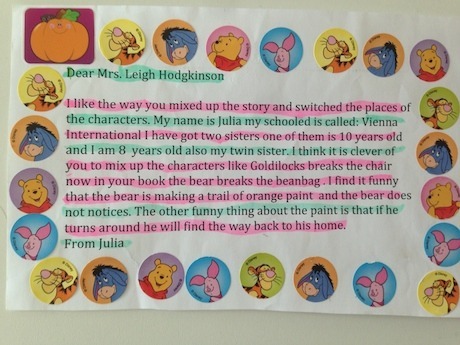
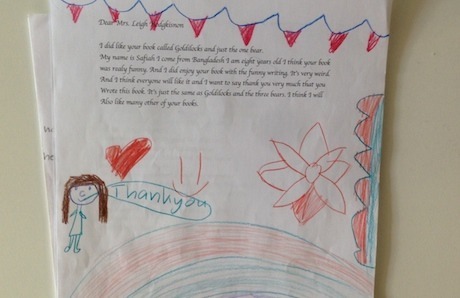
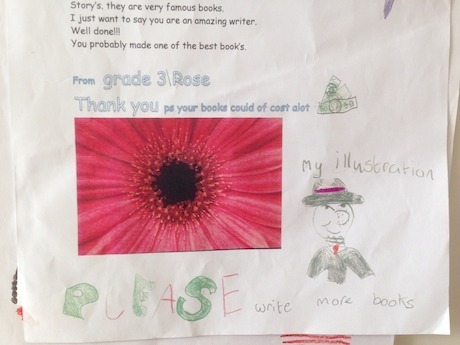
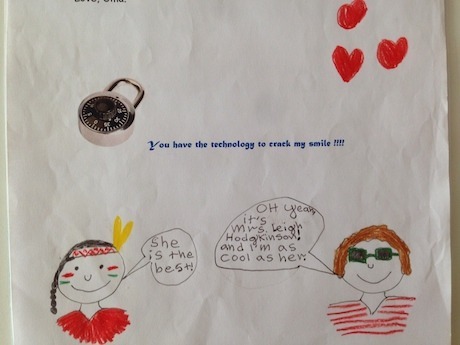
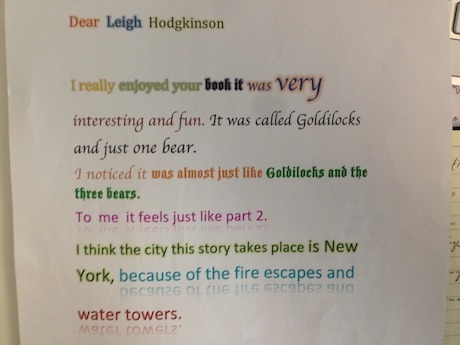
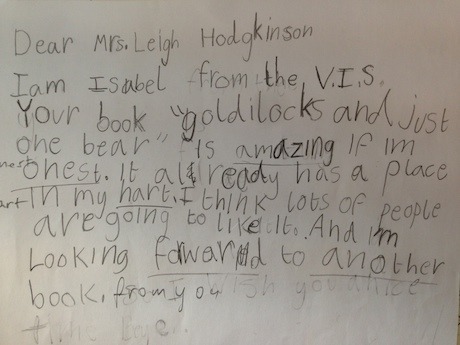
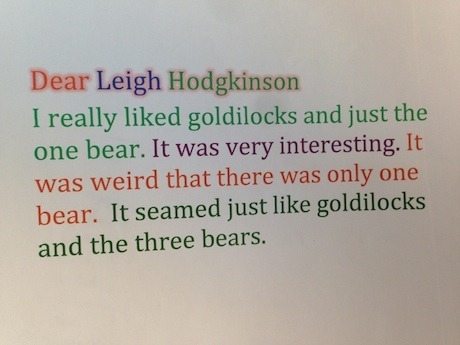
And here’s an excerpt from one particularly thoughtful letter:
“I really like this book because it was switched with Goldilocks and the three bears … I thought this was going to be the same book. But it was different. My favourite character was the Bear. I like how you had him leaving footprints that he was not aware of. I also liked it when the Bear sat on a cactus and said, “This chair is too ouch”. That is a creative word. I also liked to see that the world wobbly is written in wobbly font.”
It’s always wonderful to hear from children who’ve read books that we’ve published, but even more so when it’s another part of the world, and when they’ve found so much to enjoy in the story and artwork.
You can take a look inside Goldilocks and Just the One Bear below:
Buy the book online.
Thank you, Tini, for getting in touch and sharing these letters!

Nosy Crow's Blog
- Nosy Crow's profile
- 35 followers




